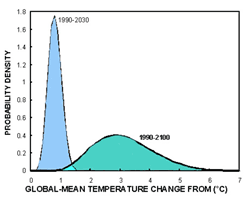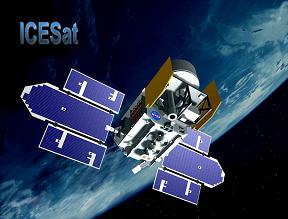Artist's impression of ICESat orbiting Earth.
Click on image for full size
Image courtesy NASA
ICESat launch
News story originally written on January 17, 2003
NASA launched the Ice, Cloud and Land Elevation satellite (ICESat) on January
12, 2003. ICESat will measure the height of the ice sheets that cover Greenland
and Antarctica. These measurements will help scientists determine whether the
ice sheets are shrinking, growing, or staying the same size. Data about the size
of the ice sheets will help answer questions about climate change, including
possible changes in sea level caused by global warming.
The main instrument on ICESat, the Geoscience Laser Altimeter System (GLAS),
uses a laser to measure the height of ice sheets in the Earth's polar regions.
ICESat was launched from Vandenberg Air Force Base in California aboard a
Boeing Delta II rocket. The satellite will orbit Earth about 600 kilometers (373
miles) up in a polar orbit that will carry it over both the North and South Poles.
The Delta II rocket also carried a second, smaller satellite.
The Cosmic Hot Interstellar Spectrometer (CHIPS) satellite will study dust and gas in space.
CHIPS is about the size of a large suitcase.
You might also be interested in:

A recent study by scientists at the U.S. National Center for Atmospheric Research has shown that there is a 90% chance that global temperatures will rise 3-9 degrees Fahrenheit over the next 100 years.
...more
It was another exciting and frustrating year for the space science program. It seemed that every step forward led to one backwards. Either way, NASA led the way to a great century of discovery. Unfortunately,
...more
The Space Shuttle Discovery lifted off from Kennedy Space Center at 2:19 p.m. EST, October 29th. The sky was clear and the weather was great as Discovery took 8 1/2 minutes to reach orbit for the Unitied
...more
A moon was discovered orbiting the asteroid, Eugenia. This is only the second time in history that a satellite has been seen circling an asteroid. A special mirror allowed scientists to find the moon
...more
Will Russia ever put the service module for the International Space Station in space? NASA officials are demanding an answer from the Russian government. The necessary service module is currently waiting
...more
During a period of about two days in early May, 1998, the ACE spacecraft was immersed in plasma associated with a coronal mass ejection (CME). The SWICS instrument on ACE, which determines unambiguously
...more
J.S. Maini of the Canadian Forest Service has referred to forests as the "heart and lungs of the world." Forests reduce soil erosion, maintain water quality, contribute to atmospheric humidity and cloud
...more















